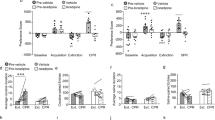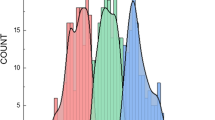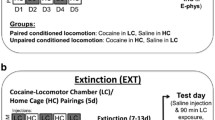Abstract
Rationale
In order to improve understanding of the nature of drug-associated memory, the current studies addressed whether conditioned place preference (CPP) could develop under conditions in which there was a delay between presentation of context and drug exposure (i.e., retrograde or trace conditioning).
Objectives
The objective was to assess development of CPP when cocaine or methamphetamine was injected simultaneously with exposure to a salient context (S+), or after delays differing in length.
Methods
Dose response curves for conventional CPP were established using separate groups of Swiss-Webster mice injected with cocaine or methamphetamine just prior to S+ exposure. To assess the development of retrograde CPP, other groups received trace conditioning, where cocaine (15 mg/kg) or methamphetamine (0.5 mg/kg) was injected after a delay of 15, 60, 120, 180, 240, or 480 min following the end of the S+ session.
Results
Mice receiving conventional CPP with cocaine or methamphetamine during S+ showed significant place preference. None of the groups receiving delayed methamphetamine showed significant CPP; however, CPP was evident in mice receiving cocaine after delays of up to 4 h following S+. In a separate study, delayed methamphetamine also did not result in significant place preference when presented in doses of 0.25 or 1 mg/kg.
Conclusions
These results suggest that psychostimulant drug taking may be broadly generalized to context through retrograde association with events in recent memory, a factor that may contribute to drug-seeking and relapse following abstinence.



Similar content being viewed by others
References
Ballard ME, Weafer J, Gallo DA, de Wit H (2015) Effects of acute methamphetamine on emotional memory formation in humans: encoding vs consolidation. PLoS One 10:e0117062
Berridge KC, Robinson TE, Aldridge JW (2009) Dissecting components of reward: ‘likingʼ, ‘wantingʼ, and learning. Curr Opin Pharmacol 9:65–73
Boakes RA, Costa DS (2014) Temporal contiguity in associative learning: interference and decay from an historical perspective. Journal of experimental psychologyAnimal learning and cognition 40:381–400
Branch SY, Beckstead MJ (2012) Methamphetamine produces bidirectional, concentration-dependent effects on dopamine neuron excitability and dopamine-mediated synaptic currents. J Neurophysiol 108:802–809
Castellano C, Zocchi A, Cabib S, Puglisi-Allegra S (1996) Strain-dependent effects of cocaine on memory storage improvement induced by post-training physostigmine. Psychopharmacology 123:340–345
Childress AR, Mozley PD, McElgin W, Fitzgerald J, Reivich M, O'Brien CP (1999) Limbic activation during cue-induced cocaine craving. Am J Psychiatry 156:11–18
Crombag HS, Bossert JM, Koya E, Shaham Y (2008) Review. Context-induced relapse to drug seeking: a review. Philosophical transactions of the Royal Society of LondonSeries B, Biological sciences 363:3233–3243
Cunningham CL, Gremel CM, Groblewski PA (2006) Drug-induced conditioned place preference and aversion in mice. Nat Protoc 1:1662–1670
Cunningham CL, Okorn DM, Howard CE (1997) Interstimulus interval determines whether ethanol produces conditioned place preference or aversion in mice. Animal Learning & Behavior 25:31–42
Dong Y, Nestler EJ (2014) The neural rejuvenation hypothesis of cocaine addiction. Trends Pharmacol Sci 35:374–383
Etscorn F, Stephens F (1973) Establishment of conditioned taste aversions with a 24-hour CS-US interval. Physiol Psychol 1:251–253
Everitt BJ (2014) Neural and psychological mechanisms underlying compulsive drug seeking habits and drug memories—indications for novel treatments of addiction. Eur J Neurosci 40:2163–2182
Fudala PJ, Iwamoto ET (1987) Conditioned aversion after delay place conditioning with nicotine. Psychopharmacology 92:376–381
Fudala PJ, Iwamoto ET (1990) Conditioned aversion after delay place conditioning with amphetamine. Pharmacol Biochem Behav 35:89–92
Garcia J, Kimeldorf DJ, Koelling RA (1955) Conditioned aversion to saccharin resulting from exposure to gamma radiation. Science (New York, NY) 122:157–158
Gatch MB, Dolan SB, Forster MJ (2016) Locomotor, discriminative stimulus, and place conditioning effects of MDAI in rodents. Behav Pharmacol 27:497–505
Gipson CD, Kupchik YM, Shen H, Reissner KJ, Thomas CA, Kalivas PW (2013) Relapse induced by cues predicting cocaine depends on rapid, transient synaptic potentiation. Neuron 77:867–872
Gonzalez Castro F, Barrington EH, Walton MA, Rawson RA (2000) Cocaine and methamphetamine: differential addiction rates. Psychol Addict Behav 14:390–396
Grant S, London ED, Newlin DB, Villemagne VL, Liu X, Contoreggi C, Phillips RL, Kimes AS, Margolin A (1996) Activation of memory circuits during cue-elicited cocaine craving. Proc Natl Acad Sci U S A 93:12040–12045
Iniguez SD, Charntikov S, Baella SA, Herbert MS, Bolanos-Guzman CA, Crawford CA (2012) Post-training cocaine exposure facilitates spatial memory consolidation in C57BL/6 mice. Hippocampus 22:802–813
Kelley AE (2004) Memory and addiction: shared neural circuitry and molecular mechanisms. Neuron 44:161–179
Prast JM, Schardl A, Sartori SB, Singewald N, Saria A, Zernig G (2014) Increased conditioned place preference for cocaine in high anxiety related behavior (HAB) mice is associated with an increased activation in the accumbens corridor. Front Behav Neurosci 8:441
Robinson TE, Berridge KC (2001) Incentive-sensitization and addiction. Addiction 96: 103–114–103–114.
Saunders BT, Yager LM, Robinson TE (2013) Cue-evoked cocaine “craving”: role of dopamine in the accumbens core. J Neurosci 33:13989–14000
Shabani S, McKinnon CS, Cunningham CL, Phillips TJ (2012) Profound reduction in sensitivity to the aversive effects of methamphetamine in mice bred for high methamphetamine intake. Neuropharmacology 62:1134–1141
Simon SL, Richardson K, Dacey J, Glynn S, Domier CP, Rawson RA, Ling W (2002) A comparison of patterns of methamphetamine and cocaine use. J Addict Dis 21:35–44
Tzschentke TM (2007) Measuring reward with the conditioned place preference (CPP) paradigm: update of the last decade. Addict Biol 12:227–462
van Huijstee AN, Mansvelder HD (2015) Glutamatergic synaptic plasticity in the mesocorticolimbic system in addiction. Front Cell Neurosci 8:466
Acknowledgments
Support for this research was provided by contract N01DA-13-8908 from the National Institute on Drug Abuse. NIDA had no further role in the design, analysis, or publication of this report.
Author information
Authors and Affiliations
Corresponding author
Ethics declarations
Conflict of interest
The authors declare that they have no conflict of interest.
Additional information
Ritu A. Shetty and Margaret A. Rutledge contributed equally to this work.
Rights and permissions
About this article
Cite this article
Shetty, R.A., Rutledge, M.A. & Forster, M.J. Retrograde conditioning of place preference and motor activity with cocaine in mice. Psychopharmacology 234, 515–522 (2017). https://doi.org/10.1007/s00213-016-4482-8
Received:
Accepted:
Published:
Issue Date:
DOI: https://doi.org/10.1007/s00213-016-4482-8




